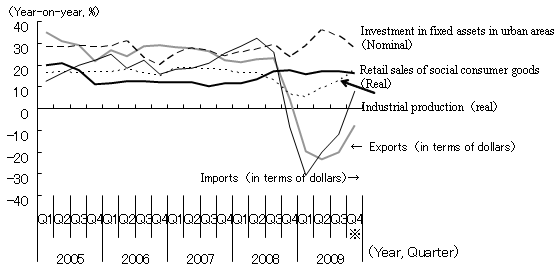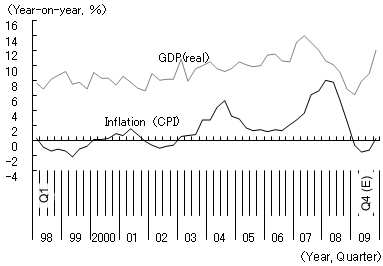A robust economic recovery
The Chinese economy, which decelerated sharply following the Lehman shock, has rebounded ahead of developed countries, thanks to expansionary fiscal and monetary policies adopted by the government. On a year-on-year basis, GDP growth had risen from a low of 6.1% in the first quarter to 7.9% in the second quarter and 8.9% in the third. Judging by macroeconomic data such as industrial production, which rose 16.1% and 19.2% year on year in October and November, respectively, GDP growth is expected to further accelerate to around 12% in the fourth quarter, giving 8.8% for the full year, exceeding the 8% growth targeted by the government.
Underlying this robust economic recovery is the fact that exports have been picking up, while domestic demand has been firm ( figure 1 ).
Figure1: Changes in Major Macroeconomic Indicators in China

(Note) For the fourth quarter of 2009, data for October and November are used. Real retail sales of social consumer goods are derived from nominal figures using CPI as the deflator.
(Source) National Bureau of Statistics of China
First, in terms of domestic demand, retail sales of consumer goods (in nominal terms) increased 15.3% year on year for the period from January to November (16.4% in real terms), as strong automobile sales (an increase of 29.5% year on year) in particular drove overall consumption. Rises in income and asset prices as well as improvements in employment should continue to support consumption. Growth in investment in fixed assets in urban areas was also high at 32.1% year on year for the period from January to November, following the adoption of economic stimulus measures of four trillion yuan centering on public investment announced in November 2008. Of this growth, investment in railways increased the most on a year-on-year basis, climbing 80.7%. It is expected that the major player of investment will shift with the economic recovery from the government sector to the private sector.
In terms of external demand, the decline in exports has been easing rapidly, with the contraction narrowing to -1.2% year on year in November. Meanwhile, growth in imports turned positive, up 26.7% year on year in November, the first positive figure since October 2008, partly reflecting the low year-ago level. In China, movements in imports are a leading indicator of exports, as intermediate goods such as components and raw materials have to be imported first to boost exports, since the ratio of processing trade to the overall trade is high. Import data for November suggests that exports will recover strongly in the months ahead. It is likely that growth in exports will turn positive in December since the yuan, which has been loosely pegged to the U.S. dollar since July 2008, has fallen against other major currencies, and the global economy is finally beginning to improve.
Asset bubble and inflation as major concerns
With the economic recovery and the easy monetary policy as the backdrop, asset prices are sharply rising and inflationary pressures are also beginning to emerge.
First, the Shanghai Composite Index, which collapsed to around 1700 points in early November 2008, has climbed sharply since then, staying above 3000 points since November 2009. Real estate prices, which experienced a temporary correction, have also been rebounding. Housing prices in 70 large and medium cities fell on a month-on-month basis for seven consecutive months starting August 2008, but began to rise again in March 2009. By November, prices were rising 5.7% on a year-on-year basis, compared with a -1.3% contraction in March. Although at this moment housing and stock prices have not yet substantially exceeded their equilibrium levels, there is certainly a risk that they could continue to rise and create a bubble.
In addition, the inflation rate (CPI on a year-on-year basis), which had been negative since February 2009, turned positive in November, at 0.6%. Given that the inflation rate lags the economic growth rate by about three quarters, it is likely to rise in the months ahead, following the recent sharp economic recovery.
Focus of macroeconomic policies to shift from sustaining growth to avoiding overheating
To maintain stable growth, the Chinese government has been forced to review its expansionary fiscal and monetary policies. The Central Economic Work Conference (held on December 5 to 7, 2009), which determined the basic economic policies for 2010, advocated that "the government needs to steadily manage (control) inflationary expectations" and "solidly control lending growth by closely monitoring changes in internal and external economic situations," while continuing to "adopt a proactive fiscal policy and moderately easy monetary policy" ( box ).
In fact, the authorities have started to seek an exit policy from the very loose monetary policy, as evident from the slower growth in lending on a month-on-month basis since the summer of 2009. Still, although year-on-year growth in lending edged down slightly from 34.4% at the peak in June, it remained high at 33.8% in November. Past experience shows that the authorities usually start to implement strong monetary tightening measures when the inflation rate as measured by the consumer price index exceeds 4%, and given the time lag between GDP growth and inflation, China is likely to reach this stage by the second half of 2010.
Figure 2: Changes in GDP growth rate and the inflation rate in China

(Source) National Bureau of Statistics of China
Both economic growth and inflation will accelerate in 2010
Thus in contrast to developed nations, the concern with the Chinese economy is overheating, rather than the loss of growth momentum (the "double dip" scenario). It is likely that growth rate will accelerate to around 9.5% in 2010, exceeding the rate in 2009, as investment and consumption stay robust in addition to the anticipated recovery in exports, while the annual average inflation rate will rise to about 3%. It is expected that although the government will adopt a tighter monetary policy in the second half of 2010, the deceleration in growth resulting from this will be carried over into 2011.
Box: Basic Economic Policies for 2010 Determined at the Central Economic Work Conference
The major targets of economic activities for 2010 determined at the Central Economic Work Conference are as follows:
- Maintaining stable and relatively rapid development of the economy by raising the level of macroeconomic control.
- Improving the quality and efficiency of economic growth by promoting economic structural adjustment.
- Expanding the room for domestic demand to increase by solidifying the growth foundation of the agricultural sector.
- Enhancing economic growth by deepening the reform of the economic system.
- Promoting the equilibrium of balance of payments by facilitating the stable growth of exports.
- Maintaining social stability by focusing on improvement in people's livelihood.
Among them, for items directly related to macroeconomic policies, it is emphasized that the government needs to "steadily deal with the relationship among the maintenance of stable and relatively rapid development of the economy, economic structural adjustment, and the management (control) of inflationary expectations" and "solidly control the degree, speed and focus of policy implementation, while continuing to adopt a proactive fiscal policy and moderately easy monetary policy."


